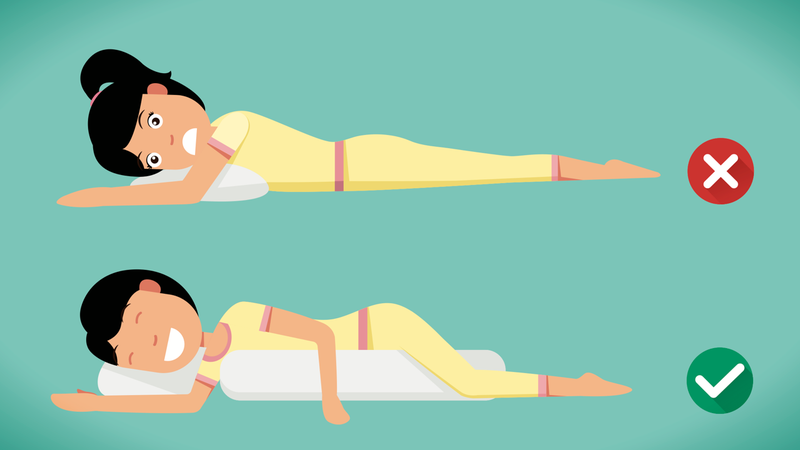
This post originally appeared on Van Winkles.
“People have more pain at night and in the morning because their joints aren’t moving,” says Joseph McNamara, a chiropractic neurologist in Cumming, Georgia. “The brain doesn’t send extra blood flow to the area.”
In addition to strain and lack of movement, back pain is caused by such conditions as scoliosis (a curvature of the spine), arthritis, spondylitis (inflammation of the joints along the spine), bulging or ruptured discs and osteoporosis.
Due to the variety of back issues, there’s no one-size-fits-all answer for how to sleep better if you suffer from back pain. There are, however, techniques that will relieve pressure on your spine by keeping it in a neutral alignment–which will help you sleep easier and wake up with less pain and stiffness. Here’s what the experts say.
If You’re a Stomach Sleeper
Sleeping on your stomach is generally regarded as the worst sleep position if you suffer from back and neck pain.
“It’s like you’re looking over your shoulder for 8 hours,” because your head needs to be twisted to one side or the other to enable you to breathe, says Dr. Ariel Blackburn, a chiropractor on Johns Island in South Carolina,
It also hyperextends the spine, which can exacerbate low back pain.
Those tight muscles then make the low back arch more, says Dr. Joseph Horrigan director of the Soft Tissue Center at DISC Sports & Spine Center
“As the arch increases, the joints of the spine (facet joints) become compressed. If these joints are already irritated or inflamed, the person can wake up with a dull, low backache,” he says.
Stomach sleeping can be so detrimental, in fact, that many doctors recommend that patients try getting used to sleeping on their sides instead.
But if you find it too difficult to fall asleep in any other position than your stomach, rotating slightly to the side and using a thin pillow could alleviate the discomfort, says Dr. Kamshad Raiszadeh, a board-certified orthopedic surgeon and co-founder of SpineZone in California.
If You’re a Back Sleeper
When you lay flat on your back, the position can put too much stress on the lower discs because you’re flattening out the lumbar lordosis (the natural forward curve of your low back), explains Matt Tanneberg a sports chiropractor and certified strength and conditioning Specialist in Phoenix.
Propping a pillow under you knees, however, promotes the normal curve of the lumbar spine and allows the low back to relax.
As for your head, don’t be afraid to be primadonna-particular about the pillow you sleep on. The wrong type can cause headaches, neck and shoulder pain and arm numbness, Raiszadeh says.
The pillow shouldn’t be fatter than the distance from your neck to your shoulder, advises Blackburn. Back-sleepers can exacerbate their pain if their heads are propped up too far forward, which creates increased neck flexion.
“If you sleep on your back, you may need a thinner pillow,” Raiszadeh says.
And that thinner pillow doesn’t necessarily have to be pricey to be therapeutic. “A small rolled-up towel or half-moon pillow under the neck can also be helpful in maintaining normal neck posture,” Raiszadeh adds.
If you want to try a special therapy pillow, McNamara recommends the cervical variety, as it “helps support the lordotic curve of the neck when you’re lying on your back and keeps the spine straight when lying on your side.”
A foam wedge under your knees might also be good idea to prevent excessive lumbar lordosis.
“Foam wedges are often preferable to pillows since pillows flatten and shift,” Raiszadeh says.
A pillow under the knees is also the best way to sleep if you have stenosis, a rare condition in which the spaces along the spine narrow, putting pressure on the spinal cord and nerves. Sleeping with a pillow under the knees flexes the back and opens the canal to relieve pressure on the cord, says Glynn Hunt, a physical therapist and certified orthopedic specialist.
The pillow-propped position is also great if you have an anteriorly rotated pelvis, adds Raiszadeh.
If You’re a Side-Sleeper
Every pregnant woman learns to sleep on their side with a pillow between the knees. But it works whether you’re with child or not: “It keeps the legs in a good neutral position and keeps the top leg from dropping to the mattress and putting the pelvis into a strong twisting (torsion) position,” says Dr. Jason Hare, a chiropractor in Nanaimo, British Columbia.
Pillow choice and placement are crucial though. The pillow should be small enough to not feel awkward between your legs, yet big enough to keep you from rolling onto your back or stomach.
If you sleep on your side, you need a pillow that’s firm and thicker—thick enough to take up the distance from your ear to the bed to keep your neck in a neutral position. Also, a pillow between your legs will help prevent the spinal rotation, Raiszadeh says.
It should be noted, however, that some of the pillow products meant to help people with back pain sleep better are unhelpful for side-sleepers.
“A person who’s mostly a side-sleeper may not do well with a contoured pillow because the contoured portion could actually cause his or her neck to be pushed out of its natural alignment,” Blackburn says. “And memory pillows are very dense and can take a patient a while to get used to. Or they might be too large, which can force their necks into flexion when they’re on their backs.”
To increase your chances of a good night’s sleep no matter what sleep position you prefer, warm baths or “sleepy” tea before bed might help.
“If you’re a chronic back pain sufferer, use heat. It will relax the low back muscles and take away some of the tension,” says Tanneberg (If you have an acute back injury, however, use ice. Heat will increase the inflammation and make your pain worse.)

No comments:
Post a Comment